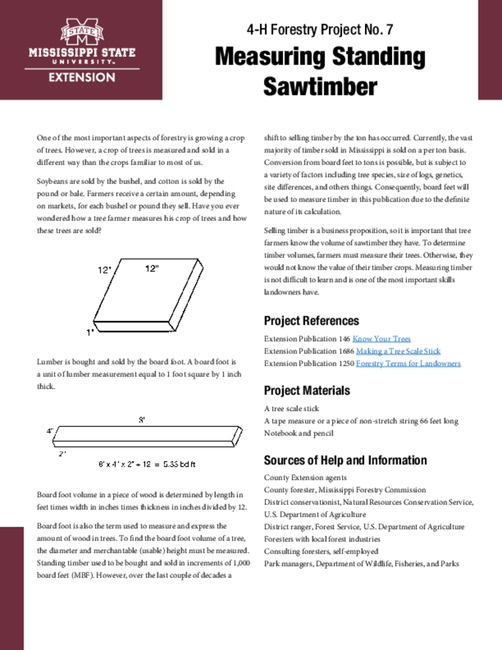4-H Forestry Project No.7-Measuring Standing Sawtimber
One of the most important aspects of forestry is growing a crop of trees. However, a crop of trees is measured and sold in a different way than the crops familiar to most of us.
Soybeans are sold by the bushel, and cotton is sold by the pound or bale. Farmers receive a certain amount, depending on markets, for each bushel or pound they sell. Have you ever wondered how a tree farmer measures his crop of trees and how these trees are sold?
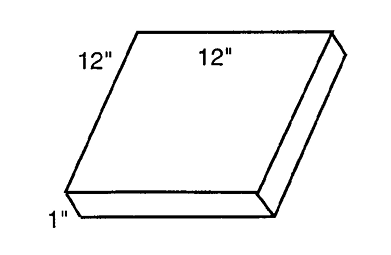
Lumber is bought and sold by the board foot. A board foot is a unit of lumber measurement equal to 1 foot square by 1 inch thick.
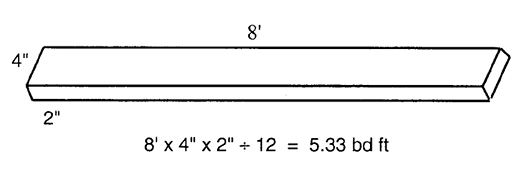
Board foot volume in a piece of wood is determined by length in feet times width in inches times thickness in inches divided by 12.
Board foot is also the term used to measure and express the amount of wood in trees. To find the board foot volume of a tree, the diameter and merchantable (usable) height must be measured. Standing timber used to be bought and sold in increments of 1,000 board feet (MBF). However, over the last couple of decades a shift to selling timber by the ton has occurred. Currently, the vast majority of timber sold in Mississippi is sold on a per ton basis. Conversion from board feet to tons is possible, but is subject to a variety of factors including tree species, size of logs, genetics, site differences, and others things. Consequently, board feet will be used to measure timber in this publication due to the definite nature of its calculation.
Selling timber is a business proposition, so it is important that tree farmers know the volume of sawtimber they have. To determine timber volumes, farmers must measure their trees. Otherwise, they would not know the value of their timber crops. Measuring timber is not difficult to learn and is one of the most important skills landowners have.
Project References
Extension Publication 146 Know Your Trees
Extension Publication 1686 Making a Tree Scale Stick
Extension Publication 1250 Forestry Terms for Landowners
Project Materials
A tree scale stick
A tape measure or a piece of non-stretch string 66 feet long
Notebook and pencil
Sources of Help and Information
County Extension agents
County forester, Mississippi Forestry Commission
District conservationist, Natural Resources Conservation Service, U.S. Department of Agriculture
District ranger, Forest Service, U.S. Department of Agriculture
Foresters with local forest industries
Consulting foresters, self-employed
Park managers, Department of Wildlife, Fisheries, and Parks
Instructions
Measuring Tree Diameter
Tree diameter is the first measurement required in measuring timber. Take this measurement at 4.5 feet aboveground on the uphill side of the tree. This measurement is known by foresters as DBH (diameter breast height) and is measured in inches.
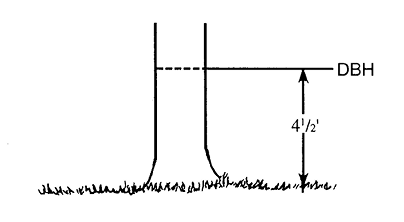
With a measuring tape, measure 4.5 feet from the ground and see where it falls on your body. Use this mark as a guide in measuring diameter.
There are many tools that can measure diameter, but one of the easiest to use is the Biltmore Stick, which is a straight wooden stick graduated for direct readings of DBH. A Doyle Rule tree scale stick (see Figure 1) will be used in this project because the Doyle Rule is the legal volume rule in Mississippi.
Use the flat side of the stick, indicated “Diameter of Tree (inches).” This side is the Biltmore Stick. Hold the stick level at 25 inches from your eye, against the tree at 4.5 feet above the ground (use the DBH mark you found earlier for this measurement). You will have to measure and practice holding the stick at the 25-inch distance from your eye.
With the stick placed against the tree, close one eye and sight at the left or zero end. This end and the tree bark should be in the same line. Move your eye across the stick to the right-hand edge of the tree. Be sure not to move your head, only your eye. Read the tree diameter to the nearest inch where the right side of the tree crosses the stick.
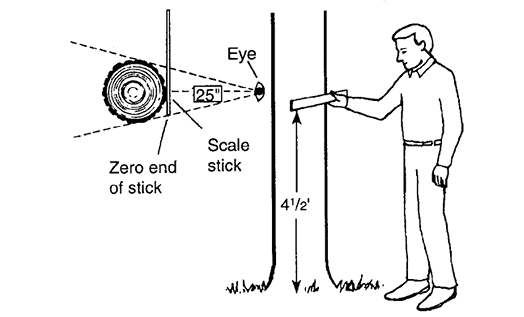
Measuring Tree Height
Merchantable tree height is the second measurement used to find board foot volume. Many different types of height-measuring devices are available; however, the Merritt hypsometer is one of the easiest to use. The Merritt hypsometer (see Figure 2) is a linear scale imprinted on one face of the tree scale stick you used in finding tree diameters. You can use this same tree scale stick to find both diameter and tree height.
To measure the merchantable (usable) height of a standing tree, you must first measure out 66 feet from the base. You can use a tape measure or a length of non-stretch string to mark this distance. With a little practice, you will learn how to pace this distance.
Always be sure you can see the entire height of the tree. Hold the stick vertical to the ground with the “number of 16-foot logs” side facing you and the zero end pointed toward the ground. Holding the stick in this position 25 inches from your eye, sight the zero end to appear to rest on the stump height of the tree. Then, without moving your head, run your eye up the stick to the point where the top of the last merchantable log would be cut.
The minimum top diameter of pine logs is 6 inches, and the minimum top diameter of hardwood logs is 8 inches. Read the number of 16-foot logs that can be cut from the tree to the nearest one-half log (8 feet). The Merritt hypsometer scale is marked in 16-foot logs, so you will have to estimate the half logs. If the top of the last merchantable log falls halfway between two 16-foot log readings, then add one-half log to the reading.
Determining Tree Volume
Volume tables determine the volume of wood in a standing tree based on DBH and merchantable height measurements. A volume table is printed on the side of your tree scale stick on the Biltmore Stick side.

After you measure the diameter and determine merchantable height, you can read across and down on the tree scale stick to find volume of the tree. For example, if DBH is measured to be 18 inches and merchantable height is three 16-foot logs, the volume would be 230 board feet (Doyle Rule).
Most volume tables give tree volumes in one-half log (8-foot) lengths, but the volume table on the tree scale stick is based on 16-foot logs. Therefore, you will have to figure the volumes for trees measured to the nearest one-half log. For example, if you measured an 18-inch DBH tree with 3.5 logs, the volume would be 247 board feet.
An 18-inch DBH tree with 4 logs has 265 bd ft
An 18-inch DBH tree with 3 logs has 230 bd ft
The difference is the volume of one log 35 bd ft
35 bd ft ÷ 2 = 17.5, rounded down to 17 bd ft for 1/2 log
Therefore,
an 18-inch DBH tree with 3 logs has 230 bd ft
one-half an 18-inch log has 17 bd ft
So, the total volume of the tree is 247 bd ft
Volume tables listed on tree scale sticks are sometimes based on different Tree Form Classes (tree taper) and may not all have the same volume figures. The standard Form Class most often used is 78. You can use whatever volumes your Doyle tree scale stick has.
Measuring Standing Sawtimber
- Contact a local forester for help in obtaining a tree scale stick (Doyle Rule).
- Locate an area with suitable sawtimber trees to measure. Pine trees must be at least 10 inches DBH, and hardwoods must be at least 14 inches DBH. Trees must have at least one 16-foot log and have a minimum top diameter of 6 inches for pines and 8 inches for hardwoods. Your own yard may have enough suitable trees, or your family may have land with sawtimber trees. State parks and national forests are ideal areas. If you have trouble locating suitable trees, get help from a local forester or Extension agent.
- Measure DBH and merchantable height (to the nearest one-half log) of 20 different sawtimber trees and enter measurements on the record sheet. Be sure to measure different species of trees. Try to measure several species of both pine and hardwood trees.
- Using the volume table on your tree scale stick, find the board foot volumes of each tree and enter them on your record sheet. Remember, you will have to determine volumes of trees with one-half logs.
- After you have measured and recorded information on all 20 trees, total the board foot volumes of all the trees. Pine and hardwood volumes are recorded separately because they are usually sold separately. Divide your total tree volumes by 1,000 board feet to get MBF.
- Contact a local forester or Extension agent and find out what the current average stumpage price is for pine and hardwood sawtimber and how to convert this information from price per ton to price per MBF. Enter this information on the record sheet. Stumpage is the value of trees as they stand in the woods uncut (on the stump).
- Multiply pine and hardwood volumes by current average stumpage prices. This will give you value of the trees you have measured. Pine and hardwood stumpage prices are different because pine and hardwood are used to make different wood products. The value and demand of these products determine stumpage price.
- If you borrowed a tree scale stick, be sure to return it to the owner after you finish measuring your trees and recording your volumes.
- If possible, get a forester to check your tree measurements and answer any questions you may have. Ask the forester to sign your record sheet when your project has been completed.
- Have your adult 4-H leader check your project and sign your record sheet. Include the record sheet in your 4-H member’s record. Save the project sheet and other materials as future references as you continue in other 4-H Forestry projects.
Open the PDF file above for the 4-H Forestry Project No. 7 record form.
Publication 1473 (POD-05-22)
Revised by Brady Self, PhD, Associate Extension Professor, Forestry, from an earlier edition by Timothy A. Traugott, retired Extension Professor, Forestry.
